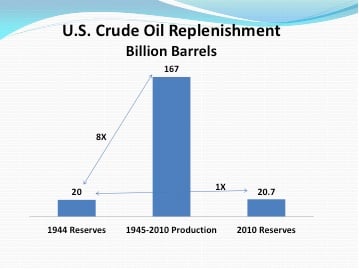Posted March 13, 2012
“The United States holds only 2% of the planet’s proven oil reserves,” President Barack Obama[i]
According to President Obama, the United States contains only 2 percent of the planet’s proven oil reserves, Of course, he’s right — to a point. In classic fashion, he’s using a technicality to skirt the facts and keep the myth of energy scarcity alive. The reality is that the U.S. has enough recoverable oil for the next 200 years, despite only having 2 percent of the world’s current proven oil reserves.
Proven oil reserves are not all of our oil resources—not even close. In fact, proved reserves represent a tiny portion of our total oil resources. Proven (or proved) oil reserves are reserves that have already been discovered, typically through actual exploration or drilling, and which can be recovered economically. That estimate does not include oil that we know about, yet are unable to access because of regulatory barriers. For example, the billions of barrels of oil in ANWR are not included in our proved oil reserves. So let’s look at the facts.
Currently, the United States has 1,442 billion barrels of technically recoverable oil, but only about 20 billion barrels are considered proven oil reserves.[ii] That is partly because the federal government is denying access to hundreds of millions of acres oil-rich federal lands: the Alaskan National Wildlife Refuge, the Naval Petroleum Reserve-Alaska, federal waters off the Atlantic and Pacific coasts, at least 45 percent of the Gulf of Mexico, the Chukchi and Beaufort Seas, and oil shale on federal lands in Colorado, Utah, and Wyoming, to name a few. In the case of oil shale (an oil composed of kerogen), technology needs to be perfected to make its production viable, but this will not happen until the land is leased. Regrettably, the Department of Interior has stopped a leasing program Congress directed it to undertake.
Proved Oil Reserves Are Not Static
Let’s take a look at history. In 1944, U.S. proven oil reserves were 20 billion barrels — about the same as they are today. Yet, between 1945 and 2010, the United States produced 167 billion barrels of oil. In other words, the United States produced over 8 times more oil than the amount of proven oil reserves it had in 1944. How can that be? The answer is that proven oil reserves are not stagnant because people keep looking for oil. Proven oil reserves keep changing, are officially recorded every year, tallied country by country, and published in the Oil and Gas Journal, among other publications. And due to U.S. entrepreneurship and ingenuity, more reserves are found and proven each year.
What happens is one or more of the following: 1) technology is found that converts hard-to-produce resources into proven reserves, 2) oil prices increase to allow more expensive types of oil to be produced, and/or 3) companies are able to purchase additional leases and explore for new basins of oil. An example of the first case where technology enables oil resources to become proven reserves is hydraulic fracturing and horizontal drilling used to produce shale oil resources, most notably in North Dakota. North Dakota now ranks third among the states in oil production.[iii] Its proven reserves have increased 25-fold in 13 years, and are likely to grow much larger. An identical increase from the rest of the United States would result in US reserves of 500 billion barrels, or almost twice those of Saudi Arabia.
What Does More Recent Data Look Like?
So, is this an historic anomaly? No. Let’s look at more recent data. In 1980, according to the Energy Information Administration, the United States had 31.3 billion barrels of proven oil reserves. However, between 1980 and 2010, the United States produced 77.8 billion barrels of oil and still had 20.7 billion barrels of oil reserves left. In other words, between 1980 and 2010, the United States produced 2.5 times the amount of oil as it has proven oil reserves in 1980.
Conventional and Unconventional Oil
Proven oil reserve data for the most part are comprised of conventional oil resources. Yet, today unconventional sources of oil are being produced. For example, Canada has proven reserves of conventional oil of only 5 billion barrels, but has 170 billion barrels of oil sands–a heavy oil whose production is based on unconventional technology –either by open pit mining or in-situ techniques, which reduce the viscosity of the oil by injecting steam and/or hot air into the oil sands. Canada’s proven oil reserves are officially set at 175 billion barrels, because it requested that oil sands be included in its proven oil reserve estimate. Canada now ranks third in the world in proven reserves, behind Saudi Arabia and Venezuela.[iv]
Conclusion
Proven oil reserves are not stagnant. They are continually changing as companies explore, find and produce oil. Declaring that “the U.S. has only 2% of the world’s oil is akin to saying that the only gasoline we will have is that which is in our tanks.” The president should know better, and if he does not, his Secretaries of Energy and Interior should tell him.
So, what can be done to increase our oil reserves? First and foremost, the United States needs to open more federal lands and waters to oil leases. Currently, only about 3 percent of government property is leased for finding energy. Once that is done, American ingenuity will take over to explore and produce those resources. ”According to a Gallup poll, an overwhelming number of consumers — 85% — say Obama and Congress should take “immediate” action to keep a lid on (gasoline) prices.”[v]
It is time our government stops misleading the American public and starts owning up to the reality of our energy situation – we are a nation rich in energy resources with poor policies that do not allow us to access them.


No comments:
Post a Comment